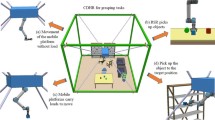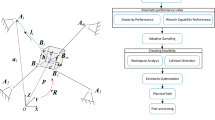Abstract
Multi-link cable-driven robots (MCDRs) have potential advantages in confined spaces exploration because of their redundancy and flexibility. Operational space wrench and acceleration capability analysis of MCDRs is important for their design, manipulability optimization, and motion planning. However, existing works mainly focus on capability analysis in the joint space. In this paper, we present a zonotope-based iterative method and a simplified capability zonotope to analyze the operational-space wrench and acceleration capability of MCDRs. In the iterative method, the capability generated by some cables can be iteratively added to the initial capability zonotope based on the Minkowski sum. In the simplified zonotope capability representation, a threshold is put forward to reduce redundant vertices and faces with little volume loss. Finally, simulations on a 24 DOFs MCDR are performed to verify the effectiveness of the developed method. The results demonstrate that our iterative algorithm can easily generate the capability zonotope with a few MB ROM, while traditional operational wrench capability evaluation without our iterative algorithm needs 18432 GB ROM. Furthermore, our simplified representation reduces the vertices and faces from 1260 and 2516 to 88 and 172, respectively, but with only 3.3% volume loss, which decreases the constraints of the robot and is conducive to manipulability optimization and motion planning.
Similar content being viewed by others
References
Axinte D, Dong X, Palmer D, et al. MiRoR—Miniaturised robotic systems for holistic in-situ repair and maintenance works in restrained and hazardous environments. IEEE/ASME Trans Mechatron, 2018, 23: 978–981
Buckingham R O, Graham A C. Dexterous manipulators for nuclear inspection and maintenance—Case study. In: 2010 1st International Conference on Applied Robotics for the Power Industry. Montreal, 2010. 1–6
Tang L, Zhu L M, Zhu X Y, et al. Confined spaces path following for cable-driven snake robots with prediction lookup and interpolation algorithms. Sci China Tech Sci, 2020, 63: 255–264
Gagliardini L, Caro S, Gouttefarde M, et al. A reconfiguration strategy for reconfigurable cable-driven parallel robots. In: 2015 IEEE International Conference on Robotics and Automation (ICRA). Seattle: IEEE, 2015. 1613–1620
Lamaury J, Gouttefarde M. Control of a large redundantly actuated cable-suspended parallel robot. In: 2013 IEEE International Conference on Robotics and Automation. Karlsruhe: IEEE, 2013. 4659–4664
Kawamura S, Choe W, Tanaka S, et al. Development of an ultrahigh speed robot FALCON using wire drive system. In: Proceedings of 1995 IEEE International Conference on Robotics and Automation. Nagoya: IEEE, 1995. 215–220
Mao Y, Agrawal S K. Transition from mechanical arm to human arm with CAREX: A cable driven ARm EXoskeleton (CAREX) for neural rehabilitation. In: 2012 IEEE International Conference on Robotics and Automation. St Paul, MN: IEEE, 2012. 2457–2462
Tang L, Wang J, Zheng Y, et al. Design of a cable-driven hyper-redundant robot with experimental validation. Int J Adv Robotic Syst, 2017, 14: doi: https://doi.org/10.1177/1729881417734458
Williams R L, Albus J S, Bostelman R V. 3D cable-based Cartesian metrology system. J Robotic Syst, 2004, 21: 237–257
Lau D, Eden J, Tan Y, et al. CASPR: A comprehensive cable-robot analysis and simulation platform for the research of cable-driven parallel robots. In: 2016 IEEE/RSJ International Conference on Intelligent Robots and Systems (IROS). Daejeon, 2016. 3004–3011
Oh S R, Ryu J C, Agrawal S K. Dynamics and control of a helicopter carrying a payload using a cable-suspended robot. J Mech Des, 2006, 128: 1113–1121
Bosscher P, Williams II R L, Bryson L S, et al. Cable-suspended robotic contour crafting system. Autom Constr, 2007, 17: 45–55
Tadokoro S, Matsushima T, Murao Y, et al. A parallel cable-driven motion base for virtual acceleration. In: Proceedings 2001 IEEE/RSJ International Conference on Intelligent Robots and Systems. Expanding the Societal Role of Robotics in the the Next Millennium (Cat. No. 01CH37180). Maui, 2001. 1700–1705
Buckingham R, Chitrakaran V, Conkie R, et al. Snake-arm robots: A new approach to aircraft assembly. SAE Technical Paper 2007-01-3870
Tang L, Huang J, Zhu L M, et al. Path tracking of a cable-driven snake robot with a two-level motion planning method. IEEE/ASME Trans Mechatron, 2019, 24: 935–946
Li Z, Wu L, Ren H, et al. Kinematic comparison of surgical tendon-driven manipulators and concentric tube manipulators. Mechanism Machine Theor, 2017, 107: 148–165
Pham C B, Yeo S H, Yang G, et al. Force-closure workspace analysis of cable-driven parallel mechanisms. Mechanism Machine Theor, 2006, 41: 53–69
Bouchard S, Gosselin C, Moore B. On the ability of a cable-driven robot to generate a prescribed set of wrenches. J Mech Robotics, 2009, 2: 011010
Eden J, Lau D, Tan Y, et al. Available acceleration set for the study of motion capabilities for cable-driven robots. Mechanism Machine Theor, 2016, 105: 320–336
Bosscher P, Riechel A T, Ebert-Uphoff I. Wrench-feasible workspace generation for cable-driven robots. IEEE Trans Robot, 2006, 22: 890–902
Hassan M, Khajepour A. Analysis of bounded cable tensions in cable-actuated parallel manipulators. IEEE Trans Robot, 2011, 27: 891–900
Yoshikawa T. Manipulability of robotic mechanisms. Int J Robotics Res, 1985, 4: 3–9
Mustafa S K, Agrawal S K. On the force-closure analysis of n-DOF cable-driven open chains based on reciprocal screw theory. IEEE Trans Robot, 2012, 28: 22–31
Rezazadeh S, Behzadipour S. Workspace analysis of multibody cable-driven mechanisms. J Mech Robotics, 2011, 3: 021005
Grünbaum B. Convex Polytopes. 2nd ed. New York: Springer Verlag, 2003
de Berg M. Computational Geometry: Algorithms and Applications. New York: Springer, 2000
Lau D, Oetomo D, Halgamuge S K. Inverse dynamics of multilink cable-driven manipulators with the consideration of joint interaction forces and moments. IEEE Trans Robot, 2015, 31: 479–488
Lau D, Oetomo D, Halgamuge S K. Generalized modeling of multilink cable-driven manipulators with arbitrary routing using the cable-routing matrix. IEEE Trans Robot, 2013, 29: 1102–1113
Taghirad H D, Bedoustani Y B. An analytic-iterative redundancy resolution scheme for cable-driven redundant parallel manipulators. IEEE Trans Robot, 2011, 27: 1137–1143
Lim W B, Yeo S H, Yang G. Optimization of tension distribution for cable-driven manipulators using tension-level index. IEEE/ASME Trans Mechatron, 2014, 19: 676–683
Author information
Authors and Affiliations
Corresponding author
Additional information
This work was supported by the China National Key R&D Program (Grant No. 2019YFB1311204), and the Shanghai Jiao Tong University Scientific and Technological Innovation Funds.
Rights and permissions
About this article
Cite this article
Sheng, X., Tang, L., Huang, X. et al. Operational-space wrench and acceleration capability analysis for multi-link cable-driven robots. Sci. China Technol. Sci. 63, 2063–2072 (2020). https://doi.org/10.1007/s11431-019-1525-0
Received:
Accepted:
Published:
Issue Date:
DOI: https://doi.org/10.1007/s11431-019-1525-0




